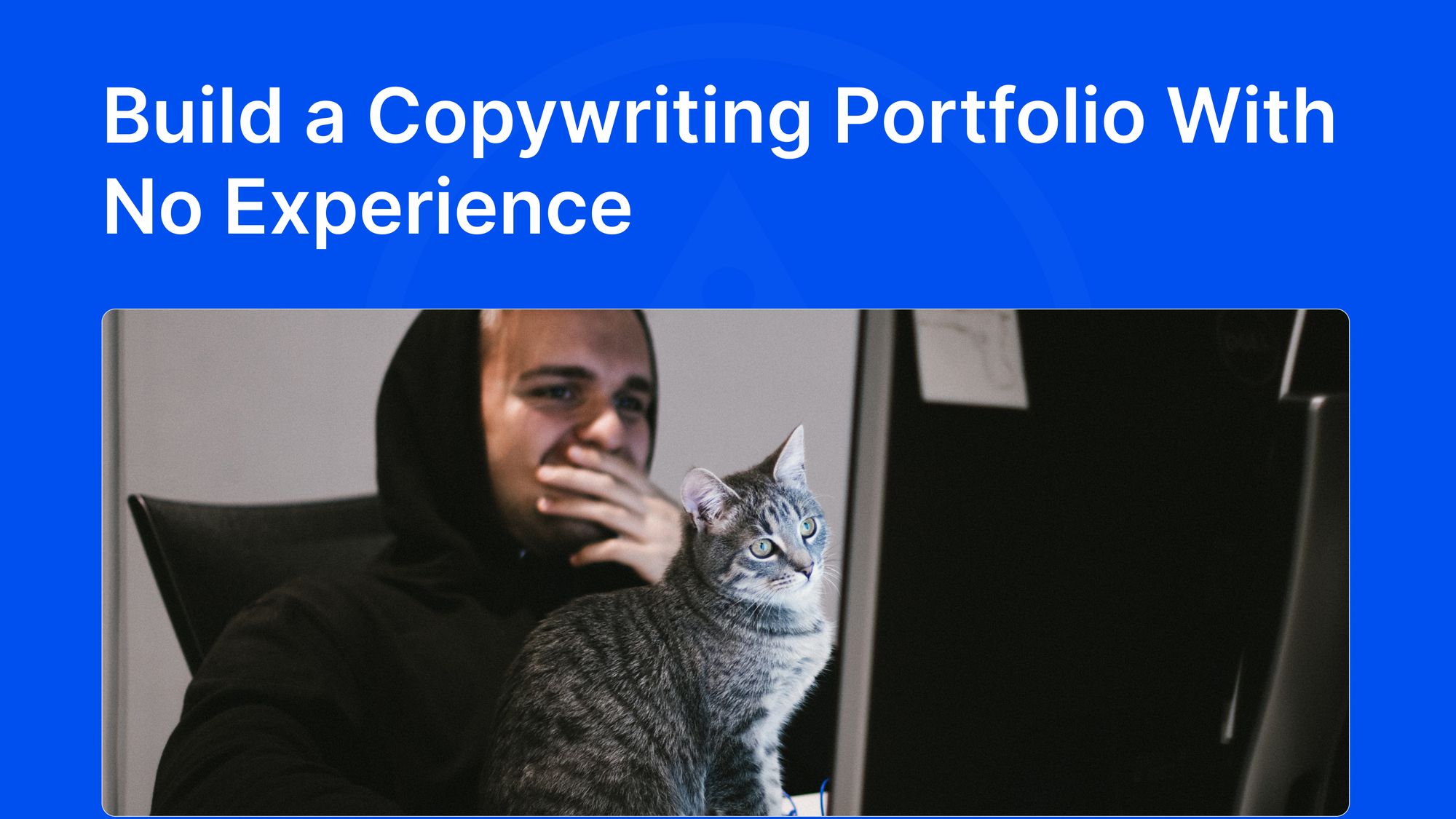You can't get a job with no experience, but you can't get experience without a job. What a nightmare.
Thankfully, there are ways to get around this Catch-22 when starting your copywriting career. If you're wondering how to create a copywriting portfolio without any experience or existing, this article might help.
Building a successful copywriting portfolio with zero experience is far from simple but is eminently doable, as long as you're willing to recognize that it will require a period of "hustle."
Let's dive in.
• Do you need to create a copywriting portfolio because you’re ready for a career change? Or perhaps you’re a copywriter who has just graduated and has decided to pursue this particular line of work?
• Either way, that’s awesome. Copywriting is quite an interesting domain and can be quite lucrative if you play your cards right. However, all that comes later. The main question here is — if you haven’t done any copywriting assignments so far, how do you build a copywriting portfolio?
• Well, you could join a course, apply for some entry-level freelance gigs, create copy for your own website, use a tool like FakeClients, create the right connections on your LinkedIn, etc. The point is, all is not lost.
• Once you’ve collected your first work samples, it’s time to create that industry-best portfolio. A LinkedIn profile is good but not enough. And a WordPress website is too much. Hence, a portfolio builder where you can optimize your portfolio for your potential client is the way to go.
• Authory is a dedicated portfolio builder that imports your content from the internet, saves it forever, proves that you do not use AI to write, provides analytics data for your content, and so much more.
How to create a copywriting portfolio with no experience
Consider joining a copywriting course
If you have literally no experience as a copywriter and want to work as one, this is the easiest way to get your foot in the door. Learning the basic skills is always the first step — some people learn on their job, but not everyone has to.
If you sign up for the right course, you'll be able to learn fundamental creative techniques, understand what clients want, and how to adjust your tone and content to industry/company/team expectations.
Think of the course as a provider of a toolkit with workable strategies and templates. However, make sure that the course will also allow you to put pen to paper (or type) and write copy. All the conceptual knowledge in the world doesn't count if you can't showcase your talent with copy work someone can actually use.
Any course worth paying should help you generate different types of copy that you can include in your portfolio website. Of course, you must clearly emphasize that the samples were generated in a class and attach proof of your attendance and completion of said course.
Volunteer for a non-profit
Is there a cause you care about? Do you like the work of a not-for-profit or charitable organization? Why not check if they have any volunteer opportunities for content writers and copywriters?
I know. It absolutely sucks to write for free or, worse, for "exposure." But there's no way to showcase your "best work" if you have no work at all.
Volunteering doesn't just help you sharpen your writing skills and gather work samples for your portfolio page. The act of donating your time and effort is a hugely positive recommendation for your work ethic and character — something plenty of potential employers will appreciate.
Ask your network for opportunities and mentors
Once you've completed your course, reach out to folks you know in the industry. If you don't know anyone in the domain — a freelance copywriter, a small business owner, etc. — LinkedIn is to the rescue!
Follow and connect with the right people and groups on LinkedIn. Create posts detailing your learned skills, and offer your services at an entry level (gotta start somewhere). With a bit of searching, you might even find reasonably priced or free mentorship programs aimed at newbies looking to create a portfolio from scratch.
There are plenty of great copywriting groups and free events on LinkedIn, so don't forget to sign up for those. They also provide excellent opportunities to network with professionals who can assist you with your online portfolio (by introducing you to work opportunities).
Look at freelance job sites
Freelance job sites like Fiver and Upwork usually have entry-level freelance copywriting work. Now, obviously, don't take on an absurd workload like 30 ad copies for $5 (Yes, that was a real job posting I saw). But consider taking one or two quick and relatively easy assignments simply for creating work samples and adding them to your portfolio.
Taking freelance gigs is also a great way to sharpen your copywriting skills, practice interacting with paying clients, and figure out your own strengths and weaknesses. You will inevitably stumble, make mistakes, and mess up, and will have to rewrite copy from scratch — so it's best to get those hiccups out of the way right at the beginning with lower-paying jobs.
Use FakeClients
FakeClients is a website that automatically generates professional industry briefs. Create copy based on these briefs, feed them into the system (you get feedback), and voila! — you have work samples without experience. Consider creating web copy, email copy, case studies, and other copywriting essentials with these briefs.
This is a great way to showcase your abilities and build your portfolio. However, be careful to notify every client that you've used machine-generated briefs. Nothing ruins your chances of success faster than a lack of transparency.
Build your own copywriter website
In all honesty, this will be hard work. You'll have to figure out how to code (if you don't already know) or use a tool like Squarespace or Wix. The latter is obviously the easier option, but you'll have to create eye-catching copy from scratch. Everything from every headline to the sales page to describing what you bring to a "brand voice" as a freelancer must be explained with precision and brevity to prospective clients.
Like I said, it will be hard work. But it will absolutely lead to you getting clients who are already impressed with your skills when they see your website copy.
Once you finish creating and gathering your initial set of work samples, it's time to organize them into a portfolio and send it to your first potential client. You can certainly build a portfolio using website builders or consider using a dedicated portfolio builder like Authory.
Authory is a tool designed to create and deploy an industry-best portfolio for writers (and multiple other professionals) as fast and conveniently as possible. If you sign up for an Authory account, here's what you get:
A self-updating portfolio (no need to keep adding new work manually)
Authory will AUTOMATICALLY import a copy of every bylined piece from every site into its own database. You can also use it to import, save, and showcase email and website copy on your portfolio. You don't have to track down links to your published work (especially older pieces). As long as you remember the URL of the site where your work exists, Authory will collate all your content for you in one dashboard.
Automated backups (never lose your content, ever)
All the content that Authory imports from different sources is saved permanently. You'll never have to worry about losing any of your published work. Even if the original website where it's published goes defunct for any reason, you'll always have a copy safely stored on Authory's server.
Continued importing of past and future content (less effort for a 100% updated portfolio)
Once you enter a source, Authory won't just import your existing publications. Anything you publish on the same site (after you've fed its URL into Authory) in the future will also be imported automatically.
There's much more, such as:
- Ability to search through both your portfolio and your content database to find articles/audio/videos based on keywords. Prospective employers and hiring managers can use this to look for topics on your portfolio, and you can use it to find specific pieces within your Authory content bank.
- Multiple, low-effort options for customization to make your portfolio visually appealing and easy to navigate.
- In-built analytics that provide real numbers on content performance (engagement, readership) across the web and popular social media sites every 30 days. You get to see how your readers/viewers are responding to your work.
Curious? Get started for FREE and see what Authory can do for you.




